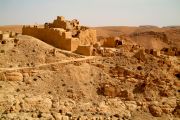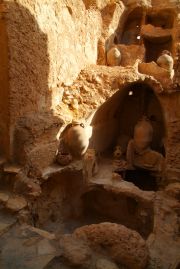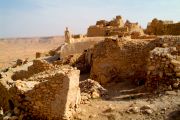This time, it was the annular solar eclipse. My first one and the last one. I loved but not as much as the total eclipse. Nalut was not particularly interesting, apart from an old Berber granary, called qasr. It has been operational since the Middle Ages.
|
Nalut was firmly on my itinerary as soon as I started planning a trip to Libya. It was not for its beauty or lack thereof. It was the city I chose to stop for the solar eclipse. As soon as I started talking to my agent (I needed one to get a permission to enter the country) about my plans and mentioned the reason, he was highly surprised. He claimed I was wrong and that the eclipse was going to happen in six months or so. He was talking about the total eclipse and obviously knew nothing about the annular eclipse, when the disc of the moon is slightly smaller than the sun's and therefore not covering it fully.
Nalut is on the way from Tripoli to Ghadames, so it made sense to break the 700 kilometre-long journey, anyway. The town itself had nothing to offer but a great old district with incredible grain warehouses, called granaries in English and 'qasr' in Arabic. The only hotel in town, where I had to stay, offered a superb view of the old town and the fortified 770 years old granary, as well as the canyon-like landscape around. I could not wait to explore it. As soon as I saw the view, I started speculating at what time I should go and check the old town out. I think it took me half an hour and one can of Pepsi to decide. Mind you, I had been travelling for over 300 kilometres, and I thought I was allowed to relax a little bit.
|
|
| Favourite spots: |
 |
 |
 |
 |
 |
 |
 |
 |
The view from the hotel's terrace
 |
 |
The old Nalut soon became my favourite spot. There was not much to do there or explore, and there were not any prominent sights, apart from the qasr. The majority of the structures were badly damaged and only few household held together, one or two in rather good condition, actually. It was clear that very poor people lived there, as the rest of the town was relatively modern. Or perhaps they just wanted to be closer to their traditions. Everything was made or built out of mud or clay. As if the town surfaced suddenly up from the desert. Not like a mirage, but sand castle constructed on an endless beach.
One could wander around freely. There was no need for guides, and there were not any guides available anyway. The site was small and easily navigable. Also, as it was perched on a hill, keeping the azimuth was straightforward with so many orientation points around.
|
|
| What's really great: |
|
As I wandered down there, which took me about ten minutes, and reached the main troglodyte qasr, I realised that some of it was locked with a padlock. There was one particular picture in my guidebook and I wanted to find where this particular part of the granary was. As I could not see it anywhere, I assumed it must have been in the locked part. I started to wander off and then a middle-aged man spotted me and asked me if I was looking around the qasr. I said yes, and he invited me to his house. It was very basic and small, but had five rooms, four of which were the size of a double bed and 130 centimetres high, and the main one was about 2 metres high and could sit, say, seven people around. I mentioned that part of the qasr was locked and he quickly jumped out, reached for his key and took me there. As soon as he opened the door, I realised that I would have missed the main part and the actual granary! I was amazed with what saw. It felt so good that Libya continued to impress me.
|
|
| Sights: |
 |
 |
 |
 |
 |
 |
 |
 |
Storage inside the inner qasr
 |
 |
This was my first qasr I saw. It was very special. It was like a small village within a village. The storage rooms were tightly packed close one to another and the passage around the qasr was very narrow, that even a donkey with a baggage would not fit there. Maybe without a baggage it would. Little light reached the palm-tree wooden doors of the storage rooms therefore. I had quite a difficulty to take decent pictures there.
I learned that the purpose of the fortified qasr was to protect the groceries, dates, produce, grain and oil of the villagers from looters, who often kept invading the villages in the middle ages of the XIII and XIV centuries. Later on, when an invasion occurred, the bandits could only rob the families of one week worth of produce, while the rest was safely locked in the granary. Each family of the village had one storage room. There were about 400 of them in Nalut and the keeper of the granary knew exactly how much each family had in their rooms at any time.
|
|
| Accommodations: |
The hotel (Winzrik Hotel, €17, en-suite single) was awful! I had an experience of a very peculiar shower. Since the bath tube was very dirty I did not have much courage to step into it. I simply stood outside of it on the bathroom floor and bent towards the shower. Water was hot only for about five seconds. Terrible!
However, when I looked outside the window I saw that weather was perfect for the eclipse, so I was happy and I did not care much about the shower. Refreshed a little, I went back to the terrace with a wonderful view, from which the eclipse should be nicely visible. As I stepped into the hotel café, I realised that I was not alone. About twenty Catalonians were humming in the café and on the terrace. They were all prepared thoroughly for the event of the day. They had filters, telescopes, and astronomical meters all set up. I thought ‘great!’, at least I will know exactly at what time the annularity will happen, because the chief of the Catalan expedition knew everything.
|
|
| Nightlife: |
There is no nightlife in Nalut. Actually, there is little public nightlife anywhere in Libya. Alcohol is prohibited, there are no discos, no pubs, no bars, no clubs... With an exception of hotel bars selling Pepsi (there is a factory in Libya) and teas. But of course there are cafes and shisha spots, which are centres for socialising, but they close early.
The only way to party at night is to befriend some young people and get invited to their houses. The best time for that is Ramadan. This is because the life moves from daytime to night time, as days are devoted for fasting, so people make as little movement as possible to burn minimum energy. At about 7 o'clock in the evening life begins. Big breakfast is served then, immediately followed by dinner. The evenings become real feasts! If at all possible many try to eat all night regularly, as much as they can, so they do not feel hunger during the day. Music is played, bonfires are fired, shishas are smoked. You name it.
|
|
| Hangouts: |
 |
 |
 |
 |
 |
 |
 |
 |
An annular solar eclipse begins
 |
 |
By the way, I found the spot of the granary from the picture in the guidebook, so I was very happy. The day was coming to an end, sunset was approaching and the play of colours and shadows at the qasr made this quick escapade the highlight of the day.
The eclipse came at 11:22 local time (09:22 UT), and it was great. The air temperature dropped and the light was slightly subdued, almost like at about 18:00 the night before. This was my first annular eclipse, and I must say it was completely different from the total eclipses I had seen before. During totality, it becomes dark with twilight at the horizon, and all becomes very calm. The birds stop singing, and some hide their heads to sleep, the stars appear in the sky and corona of the sun is clearly visible. This does not happen during an annular eclipse. The sun is not covered completely and even if its covered in 98%, there is so much light that daylight remains. Unless one knew there was eclipse happening, one would not realise.
|
|
| Restaurants: |
 |
 |
 |
 |
 |
 |
 |
 |
Households near the qasr in Nalut
 |
 |
The only restaurant I tried in Nalut was the one at the hotel. The meal was included in my 'package'. It was very basic. Some cooked vegetables and fried chicken. There was no choice. It was a set meal, a very standard thing that tourist hotels in Libya were doing across the country, with few exceptions in Tripoli and Apollonia. I have to say that I did not enjoy the meal. I would have preferred to grab some nice shawarma or lamb kebab in town, if I had a choice. But I again was very excited that I made it to Nalut and that I was going to see the solar eclipse the next day.
Interestingly, the hotel personnel must have loved Sandra, the singer from Germany, who was one of my favourites when I was in the high school, and they played gentle remixes of her greatest hits in the main café and restaurant adjacent to the terrace. So, I was looking on to this extraordinary old town of Nalut while listening to my once favourite singer from childhood. What an evening!
|
|
| Other recommendations: |
|
Nalut's qasr is the main reason why to stop there, despite the lack of accommodation options. However, since the old town can be visited in about an hour or so, one can try to avoid staying at the horrible hotel. Nearby, there are a number of small towns and villages, which offer accommodation in traditional troglodyte Berber houses, famously depicted in George Lucas's Star Wars. They are based in rectangular holes dug 5-10 meters into the desert, with an open central courtyard and rooms cut into the rock like little caves, all connected with narrow passages. They are truly remarkable and very, very special. Some of them offer very comfortable accommodation, personal touch, and genuinely friendly and homey atmosphere. There is not much to do in those towns or villages, but listening to the stories of the family, who built/adapted the traditional households is priceless. The best entertainment ever. The houses are found along the Jebel Nafusa mountain range. This photo is in Abohamam.
|
|
Published on Thursday December 18th, 2008
|
|
 Publish on Facebook
Publish on Facebook
|
Sat, Dec 20 2008 - 09:40 AM
 by pesu
| Again very interesting indeed - especially the houses in holes. |
Thu, Dec 18 2008 - 05:57 PM
 by jorgesanchez by jorgesanchez
| You are an expert to write a good report out of the stones! |
| Information: |
| Login if you are a member, or sign up for a free membership to rate this report and to earn globo points! |
|
| France |
|
|
 |
| French Guiana |
|
|
 |
| French Polynesia |
|
|
 |
| Gabon |
|
|
 |
| Gambia, the |
|
|
 |
| Georgia |
|
|
 |
| Germany |
|
|
 |
| Ghana |
|
|
|
|
|
|
 |
| Gibraltar |
|
|
 |
| Greece |
|
|
|
|
|
|
|
|
|

|
